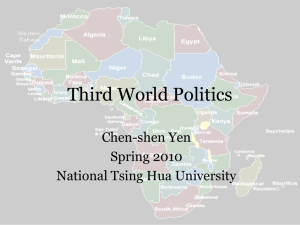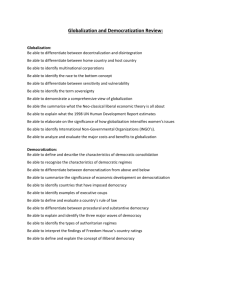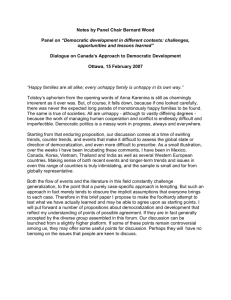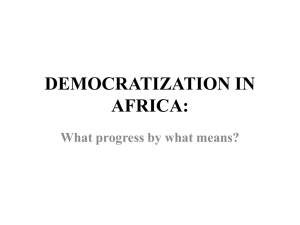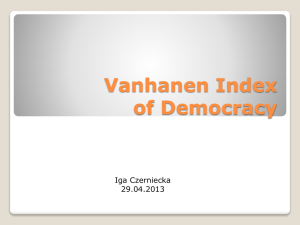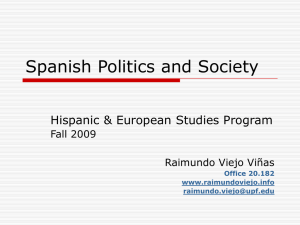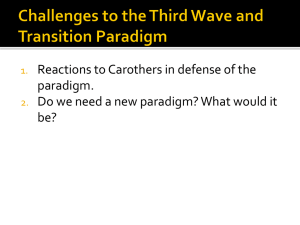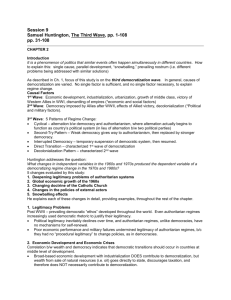Outline-Democratization
advertisement
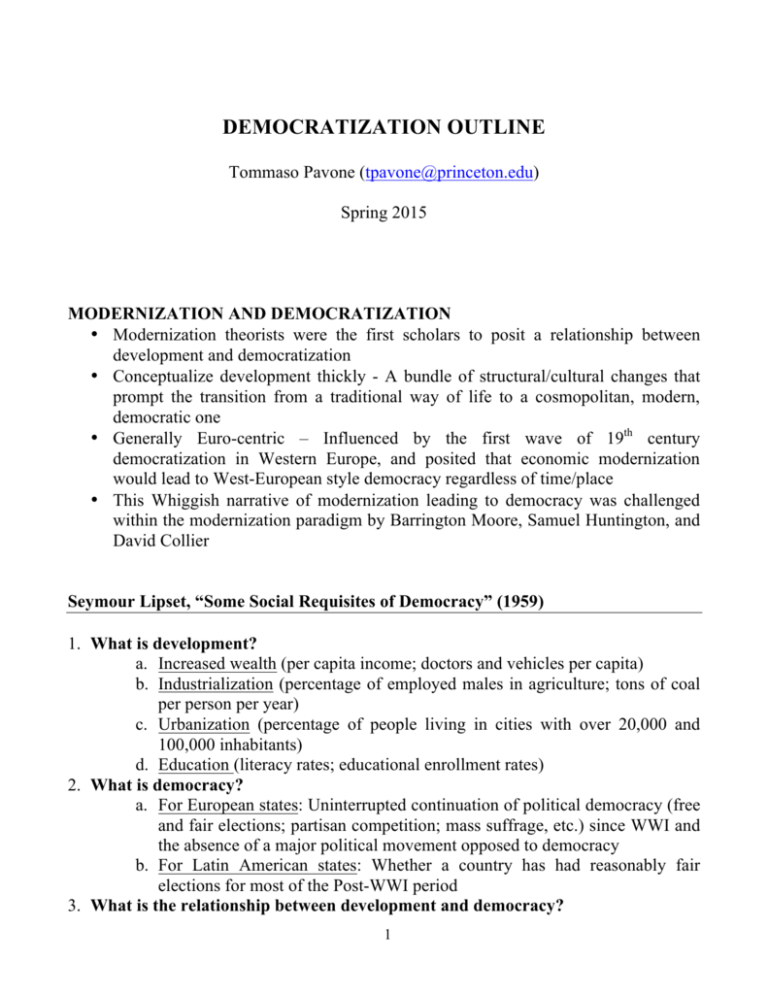
DEMOCRATIZATION OUTLINE Tommaso Pavone (tpavone@princeton.edu) Spring 2015 MODERNIZATION AND DEMOCRATIZATION • Modernization theorists were the first scholars to posit a relationship between development and democratization • Conceptualize development thickly - A bundle of structural/cultural changes that prompt the transition from a traditional way of life to a cosmopolitan, modern, democratic one • Generally Euro-centric – Influenced by the first wave of 19th century democratization in Western Europe, and posited that economic modernization would lead to West-European style democracy regardless of time/place • This Whiggish narrative of modernization leading to democracy was challenged within the modernization paradigm by Barrington Moore, Samuel Huntington, and David Collier Seymour Lipset, “Some Social Requisites of Democracy” (1959) 1. What is development? a. Increased wealth (per capita income; doctors and vehicles per capita) b. Industrialization (percentage of employed males in agriculture; tons of coal per person per year) c. Urbanization (percentage of people living in cities with over 20,000 and 100,000 inhabitants) d. Education (literacy rates; educational enrollment rates) 2. What is democracy? a. For European states: Uninterrupted continuation of political democracy (free and fair elections; partisan competition; mass suffrage, etc.) since WWI and the absence of a major political movement opposed to democracy b. For Latin American states: Whether a country has had reasonably fair elections for most of the Post-WWI period 3. What is the relationship between development and democracy? 1 a. Analytic strategy: Synchronic, cross-national statistical analysis (first quantitative analysis of its kind) b. Correlational findings: Wealth, urbanization, education, and industrialization correlate with democracy c. Posited mechanisms: i. Social mobilization: The process of social and cultural change that happens when substantial parts of a country’s population move from traditional ways of life to modern ways of life. Urbanization and industrialization dislodge individuals from the rural hinterlands to the city and from agricultural occupations to industrial occupations. This increases face-to-face contact, and civic associationism. This engenders moderation, rationality, and cosmopolitanism ii. The emergence of the bourgeoisie: modern bourgeois men are more likely to hold norms of toleration and to be politically moderate, which is a precondition for rational, Western-style democracy Daniel Lerner, The Passing of Traditional Society (1958) 1. What is development? a. Urbanization- the transfer of population from scattered hinterlands to urban centers that stimulates and provides the conditions needed for take-off towards widespread participation ! b. Raised literacy- only when 10% of a country’s population lives in cities does literacy rise significantly. It is a precondition for the emergence of a modern media system ! c. Increased modern media exposure- where oral, face-to-face contact within homogenous groups is replaced by mediated broadcasts consumed by a heterogeneous ! d. Increased economic and political participation- A person becomes a participant by learning to have opinions- and the more numerous and varied the matters on which he has opinions, the more participant he is ! e. Democratic governance (the crowning institution of the participant society) 2. What links development to democracy? a. The emergence of the mobile person, who is capable of enlarging his identity via empathy, specifically via: i. projection: enlarges identity by assigning other individuals certain preferred attributes of the self- others are incorporated because they are “like me” ii. introjection: enlarges identity by attributing to the self certain desirable attributes of others- others are incorporated because I am “like them” 2 b. The mobile person is unique to modern society: He is literate, urban, and both an economic and a political participant Barrington Moore, Social Origins of Dictatorship and Democracy (1966) 1. Key contributions: Not all modernization paths peacefully lead to democracy a. Not all modernizing paths lead to democracy: Leveraging a neo-marxist approach focused on the emergence of social classes and inter-class coalitions, Moore argues that there are three historical routes from agrarianism to the modern industrial world: (1) the capitalist democratic route, (2) the capitalist reactionary route, and (3) the communist route. The key link between economic development and democracy is the necessary presence of an urban bourgeoisie: “No bourgeois, no democracy.” b. Modernization is inherently violent: Even in the capitalist-democratic route, what is necessary is the eradication of the peasantry, often via violence. There is no peaceful developmental path from the traditional into the modern world. 2. Development ! Democracy: The Capitalist-Democratic Route a. Key characteristics: the peasantry is either subordinate to the political and economic power of the bourgeoisie and the landed aristocracy, or it had been eliminated alltogether. Via the commercialization of agriculture and urbanization, the bourgeoisie emerges as the most economically and politically powerful actor, and the aristocracy either does not oppose its democratizing efforts or it was destroyed by it in a bourgeois revolution b. Empirical example: The English path to democracy: i. Peace between crown & aristocracy ! ii. Commercialization and capitalization of agriculture ! iii. Destruction of the peasantry (via the Enclosure Movement) ! iv. Urbanization and the emergence of a strong bourgeoisie ! v. Convergence of interests between aristocracy and bourgeoisie ! vi. Bourgeois-aristocratic alliance ! vii. Parliamentary democracy 3. Modernization Trajectories not leading to Democracy: Fascism and Communism a. The capitalist-reactionary route (to fascism): the landed aristocracy and bourgeoisie are weak, and the peasantry poses a lthreat to their interests. As a result, the aristocracy and bourgeoisie “throw themselves at the royal bureaucracy, exchanging the right to rule for the right to make money.” This bourgeois-aristocratic coalition fosters an authoritarian state punctured by brief periods of quasi-democratic rule. What brings totalitarian fascism to was their reluctance to enact structural changes in the face of political or 3 economic crisis, allowing reactionary leaders bring about a fascist revolution from above. i. Empirical example: the German path to fascism: 1. Peasantry poses threat to aristocracy and bourgeois interests ! 2. Bourgeoisie and aristocracy are independently too weak to suppress threat ! 3. Aristocratic-bourgeois alliance turns to the state to protect their interests ! 4. Mildly authoritarian, conservative state emerges ! 5. Economic crisis strikes and regime is unable to reform ! 6. Reactionary leader brings about revolution from above ! 7. Fascist dictatorship b. The communist route: Here, a large peasantry lacking in social stratification emerges as the historical agent of social change. The landed aristocracy is weaker, and is unable to transition to commercial agriculture, which prevents an urban bourgeoisie from forming. The peasantry is dependent on an agrarian bureaucracy rather than the landed elites, and when the bureaucracy passes a policy that infuriates the peasantry, they mobilize to take over the bureaucracy in a communist revolution from below. i. Empirical example: the Chinese path to communism 1. Weak commerce ! 2. No bourgeoisie ! 3. Powerful peasantry ! 4. Strong agrarian bureaucratic state ! 5. Peasants become dependent on state rather than aristocracy ! 6. State infuriates peasants via arbitrary extraction ! 7. Peasant-led revolution from below ! 8. Communist dictatorship Samuel Huntington, Political Order in Changing Societies (1968) 1. Key contributions: Modernization compromises political stability a. What matters is not the form of government, but state capacity: The most important political distinction among countries concerns not their form of government but their degree of government.” In developing countries, there is a shortage of political community and of effective, authoritative, legitimate government. b. Modernization can compromise political stability: Violence and instability were in large part the product of rapid social change and the rapid mobilization of new groups into politics coupled with the slow development 4 of political institutions capable of incorporating these new claims and actors within the polity c. Therefore, modernization is not an unqualified good: Insofar as rapid development compromises political stability, it engenders bad government, for the function of government is to govern. 2. What is modernization? a. Modernization is comprised of urbanization, industrialization, secularization, democratization, education, and media participation (following Lipset (1959)) b. Modernity vs. modernization: i. Modernity=stability, but modernization = onstability 3. How does modernization undermine political stability? a. The rate of modernization matters: The degree of instability is related to the rate of modernization. The faster the enlightenment of the population, the more frequent the overthrow of government. b. The mechanism- social frustration via economic inequality: Economic growth and development increases material well-being at one rate, but social frustrations at a faster rate i. Social mobilization increases awareness of inequality and resentment of it, turning it into a stimulus for rebellion ii. Economic development in the short run tends to exacerbate income inequalities 4. Where is development most likely to produce political instability? a. Political instability depends on the level of economic development: i. Modernization + poor country = political instability ii. Modernization + medium-wealth country ≠ political instability iii. Modernization + wealthy country = political stability b. Political instability depends on the degree of political institionalization: i. Modernization + Communist/consolidated democracy ≠ political instability 1. Communist polities and consolidated democracy are best able to incorporate new demands and new social actors within the polity, channeling reform within institutions ii. Modernization + Monarchical/weak democracy = political instability 1. Monarchical and weak democratic regimes lack the political capacity to incorporate new demands and new social actors within the polity, spurring calls for extrainstitutional change 5 David Collier, Industrial Modernization and Political Change: A Latin American Perspective (1978) 1. Modernization does not lead to democratization in Latin America a. The affinity between modernization and authoritarianism: Drawing on Guillermo O’Donnell’s work, there is an affinity between industrial modernization and bureaucratic authoritarianism. Highly repressive, authoritarian governments emerged in the most advanced countries of Latin America. i. Bureaucratic authoritarianism: excluding and emphatically nondemocratic, the main actors are high-level technocrats working in close association with foreign capital. These elite eliminate electoral competition and control political participation b. Modernization does not always engender greater equality: Higher levels of industrial modernization in Latin America have coincided with new and in some cases exceptionally harsh forms of authoritarian rule and a heightening of inequality (especially in Argentina, Brazil, Chile, and Uruguay) IS DEMOCRATIZATION ENDOGENOUS OR EXOGENOUS TO DEVELOPMENT? • Development is “thinned” as a phenomena, captured by one proxy: GDP per capita • The central debate: Does economic development lead to democracy (endogenous democratization), or does it merely engender democratic stability while democratization remains independent of development (exogenous democratization)? Adam Przeworski and Fernando Limongi, “Modernization: Theories and Facts” (1997) 1. Defining endogenous and exogenous democratization a. Endogenous democratization: Democracies are more likely to emerge as countries develop economically. The basic assumption of the theory is that democratization is the final stage of the modernization process, which consists of the gradual differentiation and specialization of social structures that culminates in a separation of political structures from other structures and makes democracy possible. i. Note: This is an economic-centric version of modernization theory b. Exogenous democratization: Democracies emerge independent of development but are more likely to be sustained in developed countries 6 (exogenous theory). If democracies emerge at random vis-à-vis development levels, it is still possible, as Lipset (1959) also wrote, that those democracies that emerge in more economically developed countries are more likely to survive than in their poorer counterparts. i. Note: this is not a modernization theory, as the emergence of democracy is not brought about by development 2. Findings: against endogenous democratization, for exogenous democratization a. Data: GDP/capita data post-1950, the unit is country-year b. Against endogenous democratization: dictatorships do not necessarily fall for common reasons. Indeed, it is difficult to locate a common 'threshold' at which once can be relatively sure that an authoritarian country will democratize, for the range of developmental levels at which the dictatorships survive is wide. c. In favor of exogenous democratization: development does appear to support democratic stability- thirty two democracies in the authors' sample spent 736 years with incomes above $6,055, and none of them collapsed. Indeed, democratic survival chances increase monotonically with per capita income. i. The exception is Argentina, where per capita income reached $6000 and it subsequently experienced a democratic breakdown d. Against Huntington (1968): democracies that grow more slowly are slightly more likely to die than those that grow faster Carles Boix and Susan Stokes, “Endogenous Democratization” (2003) 1. Challenging Przeworski and Limongi (1997) a. Theoretically: They fail to articulate a theory in which development induces actors in democracies to sustain that system but does not induce actors in a dictatorship to change to democracy b. Empirically: i. Przeworski and Limongi find a small but significant endogenous effect: at higher levels of income, a transition to democracy becomes more likely – yet they seem set on ignoring this result. ii. To refute the endogenous theory of democratization we must show that democratization did not follow development among those nations that took off in the 19th century in Europe 2. Findings: In favor of both endogenous and exogenous democratization a. Overview: when the status quo is democracy, income growth does increase the stability of democracy (supporting the exogenous democratization theory). But when the status quo is dictatorship, the results are the same: economic growth increases the incentives for the ruling faction to 7 democratize. Economic equality increases both the chances of a democratic transition and the stability of democratic regimes. b. In favor of both endogenous and exogenous democratization: i. The stability of authoritarianism also declines with per capita income; development increases the probability of a transition to democracy ii. The probability of democratic breakdown drops with higher levels of GDP/capita iii. Why an attenuated effect for higher levels of GDP/capita? At a per capita income of $7,000, the effects of development on political regime have already taken place: countries that were going to develop and democratize had already done so c. The causal mechanism: economic equality i. If early-industrializing countries achieved income equality at lower levels of per capita income than did later-industrializing ones, this would explain why the endogenous democratizing effect was powerful before 1950 and weaker after 1950 ii. If early-industrializing countries achieved income equality at lower levels of per capita income than did later-industrializing ones, this would explain why the endogenous democratizing effect was powerful before 1950 and weaker after 1950 Carles Boix, Democracy and Redistribution (2003) 1. Growing economic equality increases the likelihood of democratization a. Causal mechanism: As the distribution of income becomes more equal among individuals, redistributive pressures from the poorest to the wealthiest social sectors diminish. Accordingly, the costs of tolerating a mass democracy declines for economic elites. b. Implications for endogenous democratization: The causal effect of economic development on democracy is likely to work through the mechanism of greater economic equality c. Empirical findings: Using data on income equality from 1950 to 1990 at the country-year level, statistical analysis finds that democratization and, particularly, democratic consolidation have been systematically bolstered by high levels of income equality 2. Growing capital mobility increases the likelihood of democratization a. Causal mechanism: As the mobility of capital increases, tax rates necessarily decline to prevent capital flight – or capital holders transferring their assets abroad. As the redistributive pressures on capital holders declines and their ability to shift assets abroad increases, their support for an authoritarian solution declines and the likelihood of democracy rises. 8 b. Implications for endogenous democratization: Economic modernization implies a shift from an economy based on fixed assets (such as agricultural economies based on land) to and economic system based on highly mobile capital. It is also associated with the accumulation of human capital, which is harder to expropriate. 3. Against North (1990) / North & Weingast (1989) a. Institutions do not sustain democracy: Constitutions do not sustain democratic equilibria because constitutions result simply from the fact that no actor has any incentive to deviate from a democracy-compliance strategy. This, in turn, is a function of economic parameters – the level of economic equality and of capital mobility. Douglass North, Institutions, Institutional Change and Economic Performance (1990) 1. An institutional theory supportive of exogenous democratization a. Institutions and economic activity: i. When transaction costs are negligible, the Coase Theorem institutions are unnecessary and the neoclassical theory of free market exchange holds. Yet in reality “it is costly to transact,” and thus production costs not only incorporate inputs of land, labor, and capital, but also the costs of defining, protecting, and enforcing property rights. ii. Hence North concludes that “impersonal exchange with third-party enforcement” has “been the critical underpinning of successful modern economies involved in the complex contracting necessary for modern economic growth” 1. The underlying logic is that institutions are a means for the bargaining parties to prevent ex post opportunism ex ante b. Democratic institutions foster economic growth: i. Autocracies will not see much economic growth: While a history of good behavior by the sovereign may facilitate making credible commitments, evidence from the history of medieval states demonstrates that even seemingly reliable sovereigns reneged on past promises when an alternative, more plentiful source of funds emerges ii. Democracies will see more economic growth: Modern, complex societies also require formal institutions – particularly a constitution and an effective judiciary – to reduce transaction costs and protect property rights. These institutions are the underpinnings of constitutional democracy c. Implications for exogenous democratization: Economic development and democratic stability go together not because economic growth fosters 9 democratic consolidation, but because democratic consolidation fosters economic growth. i. This supports the correlational findings of exogenous democratization theory, but via a reversed causal mechanism Douglass North and Barry Weingast, “Constitutions and Commitment” (1989) 1. The mutually constitutive nature of democratic institutions and growth a. The case study: The 1688 Glorious Revolution in England i. Pre-1688: The crown’s unpredictable fiscal needs engendered arbitrary expropriation of wealth. Parliament had little capacity to oppose the Crown. Judges critical of the crown were removed from office. As a result, economic growth was weak. ii. Post-1688: Parliamentary assent to extract revenue and modify preexisting agreements. The independence of the common law courts was secured, and judges were better able to uphold contracts and to secure property rights. As a result, a financial revolution graced England b. The mutually constitutive nature of democratic institutions and growth i. Parliamentary and judicial empowerment in post-1688 England engendered a system of checks and balances ii. The common law courts protected property rights and expanded civil and political rights iii. Parliament represented the financial interests of the urban bourgeoisie and committed to bolstering the government’s financial position iv. Investors and economic entrepreneurs were reassured that arbitrary expropriation was a thing of the past, and that the government would repay its loans v. Emerging capital markets mobilized savings, provided financial services, and financed business activities within an increasingly integrated national market vi. he government was able to tap moneyed interests in an unprecedented way: within nine years, government expenditures and debt quadrupled, providing England with the necessary resources to defeat the French in war vii. Hence the democratic state endured and consolidated, and economic growth continued c. Implications for exogenous democratization: Exogenous democratization theory that economic growth enhances democratic stability (even if it does not cause democratization) is not due to a unidirectional causal process: Democratic institutions and economic growth bolster one another 10 Michael Ross, “Does Oil Hinder Democracy?” (2001) 1. When economic development does not lead to democratization a. When economic development is spurred by government control of mineral resources: Oil wealth and authoritarianism are linked 2. Three mechanisms linking oil wealth to authoritarianism a. The rentier effect: governments use their oil revenues to relieve social pressures that might otherwise lead to demands for greater accountability. i. When governments derive sufficient revenues from the sale of oil, they are likely to tax their populations less. Statistical regression results confirm this correlation. ii. Oil wealth may lead to greater spending on patronage. Statistical regression results confirm this correlation. b. The repression effect: Citizens in resource-rich states may want democracy as much as citizens elsewhere, but resource wealth may allow their governments to spend more on internal security. i. given the opportunity to better arm itself against popular pressures, an authoritarian government will readily do so. Statistical regression results confirm this correlation. c. The lack of modernization effect: if economic development does not produce a bundle of cultural and social changes – occupational specialization, urbanization, and higher levels of education – it will not result in democratization. i. Development via oil wealth is unlikely to spur social and cultural modernization. Statistical regression results confirm this effect, particularly the lack of occupational specialization. WHO SUPPORTS DEMOCRATIZATION? Dietrich Rueschemeyer, Evelyne Stephens, and John Stephens, Capitalist Development and Democracy (1990) 1. The “Relative Class Power Model of Democratization” a. The argument: It is the growth of a counter-hegemony of subordinate classes and especially the working class- developed and sustained by trade unions, working class parties, etc.- that is critical for the promotion of democracy. b. Democratization is the product of class interest: It was the subordinate classes that fought for democracy, whereas the classes that benefitted from the status quo almost without exception resisted democracy. 11 2. How economic development supports democratization a. Capitalist development strengthens the working class: socioeconomic development enlarges the size of the working class and it increases the organizational power of subordinate classes generally b. Capitalist development erodes the power of the landed aristocracy: Via commercialization and industrialization, capitalist development erodes the size and power of the most anti-democratic force - the landowning classes. Daron Acemoglu and James Robinson, Economic Origins of Dictatorship and Democracy (2005) 1. A Theory of Democratization: Elites vs. Citizens a. The actors: Elites (usually richer and fewer in number), and citizens (usually poorer and greater in number) b. Regime types: democracies (where government represents the preferences of the whole population), and non-democracies (where government represents the preferences of a subgroup of the population – the elites) c. The democratization process i. Economic crisis temporarily shifts de facto political power from elites to citizens ! ii. Citizens pose a revolutionary threat of massive expropriation ! iii. Elites lack the coercive resources to repress the citizens en masse ! iv. Elites make a credible commitment to reform by providing more political power to citizens via democratization 2. The role of the middle class a. A strong middle class enhances the prospects of democratization: A large and affluent middle class may act like a buffer sheltering the elites from the citizens in a democracy. It does this by simultaneously making democratization more attractive for the elites than repression and changing policy enough that the citizens are content not to revolt. This is because the middle class will support only moderate redistribution (massive redistribution would expropriate wealth from the middle class as well). Beatriz Magaloni, Voting for Autocracy (2006) 1. When economic development bolsters autocracy in the short-term a. Hegemonic party autocracies can survive in the short to medium term by bolstering economic growth i. Voters are likely to support the autocrat sincerely when it puts in place policies that make the economy prosper, industry develop, and 12 wages and employment increase. If there is a history of economic growth under the party, voters will tolerate short-term crises. 2. Why would economic development lead to democratization in the long-term? a. By decreasing the dependence of the populace on autocratic government: Economic growth in the long term will work against hegemonic parties by facilitating voters from making ideological investments, thereby liberating voters from their dependence on government transfers. If the party is able to use force/exclusion from spoils as a deterrent, then the party is in a selfreinforcing authoritarian equilibrium. If not, democratization is likely. b. By bolstering economic equality: growing equality and economic development encourage democratization because they reduce the value of the strategy of vote buying. Eva Bellin, “Contingent Democrats” (2000) 1. The bourgeoisie and labor are contingently democratizing forces a. The capitalist bourgeois are “contingent democrats:” Their support for democracy depends on their material interests, which is a function of: i. State dependence (the degree to which private sector profitability is subject to discretionary support of the state) 1. When state dependence is high, capital becomes diffident about democratization because capitalists recognize that their profitability hinges on state discretion ii. Fear of redistribution: Private sector capital is everywhere concerned with protecting property rights and securing the long-term profitability of its investments through the guarantee of order. But where poverty is widespread and the poor are potentially well mobilized, their mass inclusion and empowerment associated with democratization threatens to undermine the basic interests of many capitalists b. Example - Indonesia: The state always supported capital and entrepreneurs; and the poor were a large segment of the population that posed a distinct threat of ethnic conflict and social disorder. Capitalists were thus not enthusiastic about democratization. c. Example – South Korea: Pre-1987 capital was dependent on the state and fearful of the large poor population; it opposed democratization. Post-1987 the poor had substantially decreased as wealth extended to most of the population, and capital had become competitive enough to no longer be dependent on the state; it supported democratization. 2. Labor is a contingently democratizing force 13 a. Laborers are “contingent democrats (contra Rueschemeyer, Stephens, and Stephens 1990):” Their support for democracy also depends on their material interests, which is a function of: i. State dependence (he degree to which organized labor depends on state support for its organizational viability, vitality, and clout) 1. When state dependence is high, the benefits of democratization are reduced, and consequently labor becomes less of a democratizing force ii. Aristocratic position (the degree to which organized labor is economically privileged vis-à-vis the general population) 1. When labor’s aristocratic position is high, it is likely to exhibit some dissolidarity from the unorganized masses. b. Example – South Korea: In the Korean case low scores on state dependence and aristocratic position help explain organized labor’s interest in and capacity for embracing democratization. POLITICAL/DYNAMIC APPROACHES TO DEMOCRATIZATION • Political approaches tend to focus less on structure and more on agency and its role in democratization processes • These approaches are less deterministic than the literature on development and democracy; they emphasize contingency, strategic interactions, and sequencing of events Dankwart Rustow, “Transitions to Democracy: Toward a Dynamic Model” (1970) 1. A genetic model of democratization a. Genetic theories of democracy focus on politics and human agency. Democratization usually takes the following form: i. The emergence of national unity (the sole precondition/necessary condition of a democratic transition) ! ii. An entrenched and serious political conflict ! iii. A conscious adoption of democratic rules to resolve the conflict ! iv. Politicians and the electorate are habituated to these rules 2. National unity: the sole precondition a. National unity defined: Where the majority of citizens in a democracy-to-be have any doubts about which political community they belong to. National unity is a precondition, but when it occurs is irrelevant (immediately before transition, or way back in prehistory). 14 i. Because national unity is the sole precondition, economic development is not treated as a necessary condition. Economic preconditions or economic clashes did not seem to explain democratic transitions in India, the Philippines, and Lebanon. 3. Political struggle: the catalyst a. Spurring democratization: The dynamic process of democratization is set off by prolonged and inconclusive political struggle; often emerging as a result of a new elite arising. 4. The democratic pact: the transition moment a. The pact defined: a deliberate decision by political leaders to accept the existence of diversity in unity, and to institutionalize some crucial aspect of democratic procedure. Some key features of the pact include: i. The democratic content of the decision may be incidental to other substantive issues. ii. If it is a genuine compromise, it will seem second-best to all parties involved iii. The agreement is worked out by leaders and is from universal 5. The habituation phase: democratic consolidation a. Habituation defined: A distasteful decision that seems second-best to all, once made, is likely to seem more palatable as one is forced to live with it. It requires convincing others. Democracy is a process of trial and error, a joint learning experience. This is likely to occur in a series of phases: i. Both politicians/citizens learn from the successful democratic resolution of some issues to put faith in the democratic process. ii. Experience with democratic techniques will confirm the politicians in their democratic practices/beliefs iii. The population will become firmly fitted into the new structure by forging effective links of party organization connecting politicians with the mass electorate Robert Dahl, Polyarchy: Participation and Opposition (1971) 1. Three possible democratizing paths a. Liberalization precedes inclusiveness (ex. England): i. A closed hegemony increases opportunities for public contestation and thus is transformed into a competitive oligarchy ii. The competitive oligarchy is then transformed into a democracy by increasing the inclusiveness of the regime via the expansion of political participation b. Inclusiveness precedes liberalization (ex. Weimar Germany): 15 i. A closed hegemony becomes inclusive via the expansion of political participation ii. The inclusive hegemony is then transformed into a democracy by increasing opportunities for public contestation c. Liberalization and inclusiveness occur at once (Revolutionary France): i. In this shortcut path, a closed hegemony is abruptly transformed into a democracy by a sudden grant of universal suffrage and rights of public contestation 2. The most stable path: liberalization precedes inclusiveness a. Liberalization fosters norms of compromise amongst a homogenous elite: Although the transition was rarely an easy one, and party conflict was often harsh, the severity of conflict is restrained by ties of friendship, family, interest, class, and ideology that pervades the restricted group of notables b. The masses are then socialized within democratic norms: Later, as additional social strata are admitted into politics they are more easily socialized into the norms and practices of competitive politics already developed among the elites Guillermo O’Donnell and Philippe Schmitter, Transitions from Authoritarian Rule (1986) 1. The actors within a democratic transition a. Members of the ruling coalition, which are divided into two types: i. Hard-liners, who believe that the perpetuation of authoritarian rule is possible and desirable. hey reject the cancers and disorders of democracy and believe they are on a mission to eliminate these pathologies from political life ii. Soft-liners, who are more disposed to introducing certain freedoms, because they understand the need for some form of electoral legitimation b. Members of the opposition, who are grouped into three types: i. Opportunists, who are ready to accept any offer made by the softliners ii. Maximalists, who oppose any form of negotiation and advocate a revolutionary route iii. Democrats, or the genuine and valid opposition whose moderate temperament leads them to advocate a less radical democratic transition. They are usually members of the bourgeoisie. 2. The successful transition sequence a. A weakening of the regime: This can occur either through military defeat in a war or via a conflict within the regime between the hard-liners and the soft-liners 16 b. Soft-liners triumph over hard-liners establish liberalized authoritarianism: Soft-liners tolerate/promote liberalization in belief that opening up some spaces for individual or group actions can relieve various pressures and obtain needed info and support without altering the structure of authority c. The resurrection of civil society: Once liberalization occurs, former political identities reemerge and new ones appear, expanding beyond anyone's expectations the public spaces the rulers decided to tolerate at the beginning of the transition. i. Resurrection begins with the gestures by exemplary individuals testing the waters. Common ideals are discovered; collective identifications/actions are revived; and society becomes repoliticized and angry ii. The moral leadership in this resurrection is likely to come from human rights NGOs, relatives of victims of repression, and churches d. Soft-liners and the democrats in the opposition negotiate a pact: Pacts are explicit, but not always publicly explicated/justified, agreements among a select set of actors seeking to define rules governing the exercise of power on the basis of mutual guarantees for the vital interests of those entering into it. Pacts allow a polity to change its institutional structure without violent confrontation and/or the predominance of one group over another. They converge on holding relatively free and fair elections, and thus must address: i. Which parties are permitted to play the electoral game? ii. What will be the electoral rules of the new system? iii. Will democracy be parliamentary or presidential? e. Founding elections are held: Founding elections are moments of great drama- inexperienced and suspicious voters will turn out in great numbersthe results are scrutinized avidly and carefully; and evidence suggests the outcomes will 'freeze' party system dynamics/voter preferences for at least a while 3. When are transitions likely to go awry? a. When a bourgeoisie is weak: Where the military/leader sucks the wealth from the population, the bourgeoisie is weak; thus, a loyal/competitive opposition cannot emerge; here, armed insurrection seems to be the only way for regime change and eventual democratization b. When the military aren’t offered an acceptable bargain: The military will be capable of upsetting the whole transition if it appears that sanctions against military officers for excesses will be levied, or when it appears that the opposition will resort to mass protest and violence c. In general transitions are fragile and contingent – hardliners or the military may seek to stage a coup; disillusionment post-transition by the opposition may facilitate a relapse to authoritarianism. Uncertainty reigns in the transition game 17 Samuel Huntington, “How Countries Democratize” (1991) 1. A tripartite typology of democratic transitions a. Transformations: In transformations, elites in government are the most important forces bringing about regime change. These are transitions from above. The prototypical cases were Spain, Brazil, and Hungary and the USSR. This occurs in the following phases: i. The emergence of reformers within the authoritarian regime’s ruling coalition ! ii. The acquisition of power by reformers in the authoritarian regime’s ruling coalition ! iii. The failure of the regime to liberalize in time ! iv. The standpatters are subdued and prevented from mounting a challenge to the reforms by reassuring, weakening, or co-opting them ! v. Formal negotiations, consultations, and agreements with the opposition are forged to co-opt them ! b. Replacements: In replacements, reformers within the regime are weak or nonexistent- standpatters rule. Democratization results form the opposition gaining strength and the government losing strength until the government collapses. These are transitions from below that are likely to evolve as follows: i. A student movement opposed to the regime emerges ! ii. The student movement expands to other sectors of society ! iii. The standpatters in government refuse to negotiate and reform ! iv. The military becomes dissatisfied with the regime ! v. The standpatters are disempowered and reformers within the regime negotiate a transition with the opposition c. Transplacements: In transplacements democratization is produced by the combined actions of government and opposition. Within the government the balance between standard patterns and reformers is such that the government is willing to negotiate a change of regime. Within the opposition democratic moderates are strong enough to prevail over antidemocratic radicals, but not enough to overthrow the government- so they see virtues in negotiation. The sequencing is likely to be as follows: i. The government liberalizes and loses authority ! ii. The opposition uses these trends to expand its support and intensify its activities ! iii. The government forcefully seeks to contain the opposition and suppress it ! 18 iv. The government and opposition leaders perceive a standoff and seek to overcome it by negotiating a transition Deborah Yashar, Demanding Democracy (1991) 1. The preconditions for democratic transitions a. A divided elite: When the elite remains publicly united in support of the regime, a change to democracy is unlikely. Confronted with a populace demanding change, a unified elite is more likely to engage in repression than liberalization. A publicly divided elite, conversely, creates the possibility for change. When they fragment, it creases additional latitude for opposition groups and a political opening to construct new coalitions. b. The emergence of civil society: The development of civil society generates demands for democracy that are necessary for a transition. It allows the elite to forge alliances with civil society middle classmen to secure their economic interests, thus reducing their fear of democratization. Further, civil society generates norms that are supportive of democracy. 2. The crucial variables for the success and endurance of transitions a. The ability to sustain democratizing coalitions between the urban civil society and the rural peasantry. The countryside contains two social actors that are most potentially disruptive to the transition: agrarian elites and the rural poor. Forging a transition with the countryside requires: i. Establishing the state/s autonomy from traditional elite while delineating the latter’s political stake in the existing political regime ii. Developing the organizational capacity to govern the countryside by developing political party discipline and outreach, or strengthening state bureaucracies b. The ability to partially redistribute elite property and enact reforms quickly during the transition: Actors can exploit these moments of transition to redistribute otherwise concentrated economic and political resources, but timing matters- they must do so during the transition, otherwise they cannot achieve this distribution without achieving democracy’s demise. It is best to redistribute and reform rapidly and all at once. 3. The comparative case studies: Guatemala and Costa Rica a. Guatemala – failed transition: i. The Guatemalan military applied severe repression everywhere, but nowhere more so than in the countryside. While concentrated landholdings allowed Guatemalan elite to develop powerful economic organizations, they still lacked an independent, organized political force within the government itself. In this context, the military 19 institutionalized its position through a combination of fraudulent elections and coercion. b. Costa Rica- successful transition: i. Costa Rica saw the rise of the Partido Liberacion Nacional (PLN) national party, which substantially organized a rural constituency given its lack of support from traditional elites. The party cultivated peasant support. The PLN penetrated the countryside electorally at a moment in which traditional elites were politically divided. ii. Reformers came to dominate the countryside through rapid redistributive reforms, social welfare programs, electoral incorporation, etc. 20

